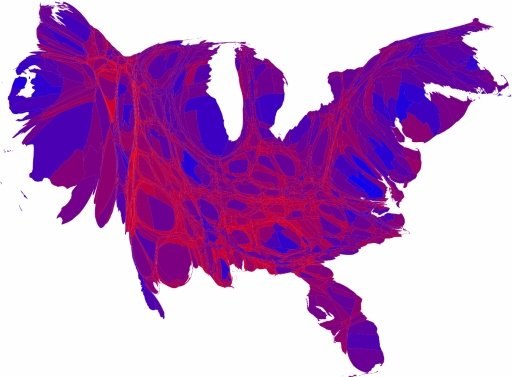Are we, as a nation, closely or deeply divided? I have always been compelled by the argument that observing a 50-50 election outcome (or an evenly split poll result) tells us very little about whether each half of the electorate hates the other half – or whether we are all just flipping coins, relatively indifferent between the choices in front of us.
Coloring states either red or blue doesn’t help to clarify this relationship. When we color U.S. counties in shades of red or blue to demonstrate the mix of support for parties across the country in a given election, we begin to see the purple – but we are no closer to understanding whether a purple county (one that was narrowly split) is deeply divided or indifferent.
Part of what is difficult here is the data. To do a legitimate job understanding between-state differences in political attitudes and behavior we would need data from all 50 states, or at least a good number of them; and we would need those data to be representative of each particular state. A nice state-level, stratified sample would be ideal, but costly – even if we could reduce costs by using the Internet. Absent this, a dataset with big enough samples in most states could substitute if we believed the data within state were representative of the state’s residents. Of publicly available datasets, the National Annenberg Election Study would probably come the closest.
Instead of looking for between-state differences in attitudes and behavior that might explain state-level support for each party, I am going to see if I can uncover between-party differences in lifestyle-type attitudes and behaviors from a nationwide sample of adults, representative of eligible voters.
Sure, everyone knows Democrats and Republicans are different --- but mainly, we understand those differences to be political. Or at least, we express them through political topics, which seems reasonable since the group memberships are presumably tied in some way to political beliefs. But what about non-political attitudes? Are Democrats and Republicans in America different socially, in terms of their recreation and hobbies? Do they watch different television shows? Take different risks?
To answer this question, I use data on 1,000 impaneled YouGov/Polimetrix respondents who completed a survey in Mid-January of 2011. Placing the leaning and weak partisans in with the partisans, these data include 444 self-described Democrats and 408 Republicans. Only 147 people stuck to the purely independent category, even when pushed.
What kinds of differences emerge across partisanship in America? Let’s start with primetime broadcast television. We asked people to tell us which of six highly popular primetime broadcast network television shows they would choose to watch. Respondents chose from among: Desperate Housewives, The Mentalist, Extreme Makeover: Home Edition, CSI:Miami, NCIS, and Criminal Minds. These shows represent popular programming across multiple networks. Overall, the winner with nearly 28% of the votes, is NCIS (CBS, Tuesdays at 8PM). Second place goes to Extreme Makeover: Home Edition (ABC, Sundays) followed by Criminal Minds, CSI:Miami, The Mentalist, and Desperate Housewives.
When we examine the viewership of each show, however, interesting partisan composition emerges. Republicans make up more of the share of the audience for NCIS (48%) and Criminal Minds (41%), while shows like Desperate Housewives (55% Democrats), The Mentalist (54%), and CSI:Miami (50%) are much more likely to be composed of Democrats than Republicans. Extreme Makeover is a pretty even mix of partisans from both parties. Where there are differences, they are significant, at least in a statistical sense.
What’s interesting about these trends in television viewing is the similarity between the programming of shows like NCIS and CSI:Miami – both shows are about forensic science and criminal investigations – yet, partisans somehow manage to sort themselves into the shows in a systematic way. Republicans are nearly half the audience for NCIS (a show about a Naval Criminal Investigative unit) while Democrats are half the audience for CSI:Miami (highlighting the same kind of criminal investigative unit, nut not one linked to the military and in the uber-hip and very cosmopolitan Miami). Another interesting difference is the sorting between The Mentalist (a show about a fake psychic who helps detectives from the California Bureau of Investigations solve crimes) and Criminal Minds (a show highlighting the work of FBI profilers working in a special unit in Quantico, VA). Over half the audience for The Mentalist are Democrats. In contrast, almost half the audience for Criminal Minds is made of Republicans (it is worth remembering that there are three categories of partisanship, not just two).
These differences exist despite the similarity of the content and programming on these shows. You don’t have to be a rocket scientist (or a political scientist for that matter) to see the one obvious pattern here: the geographic location of the show seems to correspond to the partisan sorting. Democrats like the shows that take place in Miami and California; Republicans like the shows that take place in Virginia. I wouldn’t stake my Ph.D. on it, but it isn’t a pattern I would have expected a priori.
I also asked people about several recreational activities with varying degrees of risk, like camping for more than a week, traveling alone in a foreign country, riding in a hot air balloon, skydiving, driving over 90 MPH, riding a motorcycle, and firing a handgun. Of these activities, overall, the most popular thing to have done in America was fire a handgun or rifle (54%). This was followed closely by riding a motorcycle (45%), going camping for a week or more (35%), and traveling alone abroad (24%).
Republicans, however, are systematically more likely to have ridden motorcycles (by 15 points) and fired a handgun or rifle (20 points). They are also 15-points more likely to have power tools and shop equipment in their garage than Democrats (the only item people keep in their garages to show any differences from the 8 or so we asked about). None of the other differences are appreciable.
Republicans are also 20-points more likely to be married than Democrats (42 to 62 percent) and nearly 20-points more likely to say that religion is an important part of their lives. But we might have guessed this.
Independents, interestingly, look more like Republicans on the use of guns, but more like Democrats on power tools, marriage and religion. On the others, they are squarely in the middle.
Here’s where it gets interesting: when we asked people who was mainly to blame for the shootings in Tucson at Congresswoman Gabrielle Giffords’s constituent gathering, interesting patterns by television program emerged.
As you might expect, NCIS and Criminal Minds viewers were more likely to blame the shooter alone (78%) than were viewers of The Mentalist (70%) and Desperate Housewives (61%). But even among shows for which the audience base is made of mainly Democrats (CSI:Miami, The Mentalist, Desperate Housewives) there are big differences. Seventy-three percent of CSI viewers blamed the shooter alone – a 12-point difference from viewers of Desperate Housewives. These differences are mimicked when we asked whether Sarah Palin or Glenn Beck were to blame for the violence (although the incidence rate on these items was much lower, of course).
The differences persist even if we control for party identification. It is worth noting, however, that television preferences do not explain very much of the variation in whether the shooter alone was to blame – about 1.5%. Party identification explains about 11% of the variation. Still, television show choices (even when controlling for party) explain more of the variation in whether the shooter is alone to blame for the violence in Tucson than gender or education – and it explains about half as much variation as income. Incidentally, these demographics do not do a very good job of explaining television preferences, so that’s not the driver here. Only gender has a regular effect on TV choices (women are more likely to watch Desperate Housewives and Extreme Makeover) while income only affects CSI:Miami viewership (increasing income reduces CSI:Miami viewing).
None of this of course gets us any closer to an answer to the question I started with: are we closely or deeply divided? But I’ve learned some things. It’s a big country with lots of differences in geography and opportunities. We jam all this variation into two political parties – and there must be differences within those parties that are not explained well by income, education, gender, and race. There are well-educated, rich people in San Francisco and in Pittsburgh. But even within political parties, they are just not the same.









